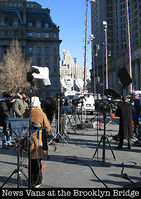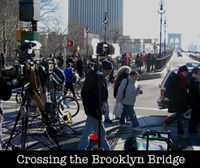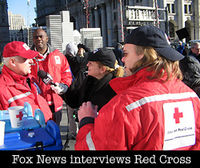IndependentFilm.com
http://www.independentfilm.com/resources/new-york-city-transit-str.shtmlNew York City transit strike.
MTA Subways and Busses are shut down by the Union.
MTA Subways and Busses are shut down by the Union.
[an error occurred while processing this directive]
Edit page New page Hide edit links
By Corey Boutilier
[editors note Fri Dec 23rd: The Strike is now over; obviously. Here is the statement from the Union to it's members.
"STRIKE OVER: RETURN TO WORK
When: If your tour has started, report immediately. If not, at your scheduled report time. If you are RDO, on your next scheduled shift.
If you can’t report to your location, report to the nearest location as if it was a snow emergency. Then contact your field office. After that, call your Union Rep or Chair.
If Management gives you any problem, call your Union Rep or Chair.
Hold your head high when you report to work."]
Dec. 21st, 2005 - New York city is currently suffering through a public transit strike. The New York City subway and bus system is effectively shut down as union transit workers are instructed to stay off the job.
The decision by Union officials to strike doesn't come easy. Because of legal maneuvering by the city of New York, every day the Union is on strike the Union is fined 1 million dollars per day. And every day a worker is on strike, they are individually fined 2 days pay. The Union only has about 3 million in the bank.
How did this happen? The Union works with the MTA under a contract. The latest contract expired. The terms of a new contract could not be agreed upon. Cooler heads could not prevail and so now we have a strike.
Mayor Bloomberg had this to say during a recent interview.
"The city can not afford this strike. Particularly during the Holiday shopping season, we will be hit especially hard. This places the public in danger, it's harder for emergency vehicles to get around, and the economy of the city will suffer."
However the Mayor did offer a polite spin on the situation. When asked if people should still come into the city he had this to say.
"New York City is a city where you walk a lot anyway. Everybody is getting along. There are taxis available. You can still get around. Sure it's inconvenient, but it's also a little bit exciting. When else will you have an experience like this."
So, how does this effect the News Media? The New York city police department was notified at around 3am on Tuesday that the the strike was on. And so too was the media told. That means that the media had several hours to prepare in anticipation of a major news event.
News vans are mobilized and news crews are set out onto the street to get "the story". Whatever story that may be. But keep in mind that what Mayor Bloomberg said is right, New York is a walking city anyway. That means that news stories are about people walking in a city that walks.
Symbolically, the Mayor will walk over the Brooklyn Bridge. Today this happened at 7am. Most of the video news coverage will focus on the Brooklyn bridge because of the sheer volume of people crossing.
As you can see in these photos, all of the major news media were at the base of the Brooklyn Bridge to capture this important story.
Here is Fox news radio looking to speak with people who crossed the Brooklyn Bridge, and only those who crossed the bridge. This news reporter didn't need to speak with anyone else. (Well, she did speak to the Red Cross volunteers for a bit) Typically, a news director will tell a reporter what story they are looking for. That's the real "News Spin" that everyone talks about. Fox news radio knows that EVERYONE has to walk today, not just people from Brooklyn. But since that's the story they want, thats who they are going to talk to.
Also, at the base of the Brooklyn Bridge, Manhattan side, the Red Cross disaster relief team was out in force to provide free cups of coffee, hot chocolate and energy bars like fig newtons for walking commuters. Again, it was 20 degrees outside but this was more symbolic in nature. It was thoughtful that the Red Cross was there.
Vehicles with less than 4 people are NOT allowed below 96th street. Be aware of that if you want to drive into the city. (No restrictions for motorcycles). There are also certain streets that have been reserved only for emergency vehicles.
Also, be aware that taxis have updated pricing during this strike. They are able pick up multiple passengers, and are now only charging by zone. The meters are off, so be aware what the zone pricing is so you don't over pay. In general the rule is 10 dollars to start, 5 dollars to cross into a new zone. (See map link below.)
Here is advice to make walking to work easier.
1. Dress warm. Thermal underwear, gloves, hat, etc.
2. Bring your ipod.
3. Bring a small bottle of water.
4. Try to remember to stretch before a long walk.
5. Wear walking shoes or sneakers.
5. If you end up sharing a cab with someone you don't know, start up a conversation. New Yorkers are cool, and you wouldn't want to miss out on meeting someone new.



